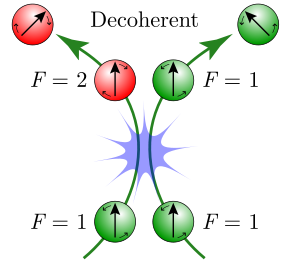SERF
Aspin exchange relaxation-free(SERF)magnetometeris a type ofmagnetometerdeveloped atPrinceton Universityin the early 2000s. SERF magnetometers measure magnetic fields by using lasers to detect the interaction betweenalkali metalatoms in a vapor and the magnetic field.
The name for the technique comes from the fact thatspin exchange relaxation,a mechanism which usually scrambles the orientation ofatomic spins,is avoided in these magnetometers. This is done by using a high (1014cm−3) density ofpotassiumatoms and a very low magnetic field. Under these conditions, the atoms exchange spin quickly compared to their magnetic precession frequency so that the average spin interacts with the field and is not destroyed by decoherence.[1]
A SERF magnetometer achieves very high magnetic field sensitivity by monitoring a high density vapor of alkali metal atoms precessing in a near-zero magnetic field.[2]The sensitivity of SERF magnetometers improves upon traditional atomic magnetometers by eliminating the dominant cause of atomic spin decoherence caused byspin-exchange collisionsamong the alkali metal atoms. SERF magnetometers are among the most sensitivemagnetic field sensorsand in some cases exceed the performance ofSQUIDdetectors of equivalent size. A small 1 cm3volume glass cell containing potassium vapor has reported 1 fT/√Hzsensitivity and can theoretically become even more sensitive with larger volumes.[3]They are vector magnetometers capable of measuring all three components of the magnetic field simultaneously.[citation needed]
Spin-exchange relaxation[edit]
Spin-exchange collisionspreserve total angular momentum of a colliding pair of atoms but can scramble thehyperfinestate of the atoms. Atoms in different hyperfine states do not precess coherently and thereby limit the coherence lifetime of the atoms. However, decoherence due to spin-exchange collisions can be nearly eliminated if the spin-exchange collisions occur much faster than the precession frequency of the atoms. In this regime of fast spin-exchange, all atoms in an ensemble rapidly change hyperfine states, spending the same amounts of time in each hyperfine state and causing the spin ensemble to precess more slowly but remain coherent. This so-called SERF regime can be reached by operating with sufficiently high alkali metal density (at higher temperature) and in sufficiently low magnetic field.[4]
The spin-exchange relaxation ratefor atoms with low polarization experiencing slow spin-exchange can be expressed as follows:[4]
whereis the time between spin-exchange collisions,is the nuclear spin,is the magnetic resonance frequency,is thegyromagnetic ratiofor an electron.
In the limit of fast spin-exchange and small magnetic field, the spin-exchange relaxation rate vanishes for sufficiently small magnetic field:[2]
whereis the "slowing-down" constant to account for sharing of angular momentum between the electron and nuclear spins:[5]
whereis the average polarization of the atoms. The atoms suffering fast spin-exchange precess more slowly when they are not fully polarized because they spend a fraction of the time in different hyperfine states precessing at different frequencies (or in the opposite direction).

Sensitivity[edit]
The sensitivityof atomic magnetometers are limited by the number of atomsand their spin coherence lifetimeaccording to
whereis thegyromagnetic ratioof the atom andis the average polarization of total atomic spin.[6]
In the absence of spin-exchange relaxation, a variety of other relaxation mechanisms contribute to the decoherence of atomic spin:[2]
whereis the relaxation rate due to collisions with the cell walls andare thespin destructionrates for collisions among the alkali metal atoms and collisions between alkali atoms and any other gasses that may be present.
In an optimal configuration, a density of 1014cm−3potassium atoms in a 1 cm3vapor cell with ~3 atm helium buffer gas can achieve 10 aT Hz−1/2(10−17T Hz−1/2) sensitivity with relaxation rate≈ 1 Hz.[2]
Typical operation[edit]

Alkali metal vapor of sufficient density is obtained by simply heating solid alkali metal inside the vapor cell. A typical SERF atomic magnetometer can take advantage of low noise diode lasers to polarize and monitor spin precession. Circularly polarized pumping light tuned to thespectral resonance line polarizes the atoms. An orthogonal probe beam detects the precession using optical rotation of linearly polarized light. In a typical SERF magnetometer, the spins merely tip by a very small angle because the precession frequency is slow compared to the relaxation rates.
Advantages and disadvantages[edit]
SERF magnetometers compete withSQUIDmagnetometers for use in a variety of applications. The SERF magnetometer has the following advantages:
- Equal or better sensitivity per unit volume
- Cryogen-free operation
- All-optical measurement limits enables imaging and eliminates interference
Potential disadvantages:
- Can only operate near zero field
- Sensor vapor cell must be heated
Applications[edit]
Applications utilizing high sensitivity of SERF magnetometers potentially include:
- High-performancemagnetoencephalographic imaging[7]
- Sample magnetization measurement, especially rock samples
History[edit]

The SERF magnetometer was developed byMichael V. RomalisatPrinceton Universityin the early 2000s.[2]The underlying physics governing the suppression spin-exchange relaxation was developed decades earlier byWilliam Happer[4]but the application to magnetic field measurement was not explored at that time. The name "SERF" was partially motivated by its relationship to SQUID detectors in a marine metaphor.
References[edit]
- ^Allred JC, Lyman RN, Kornack TW, Romalis MV (2002)."High-sensitivity atomic magnetometer unaffected by spin-exchange relaxation".Phys Rev Lett.89(13): 130801.Bibcode:2002PhRvL..89m0801A.doi:10.1103/PhysRevLett.89.130801.PMID12225013.
- ^abcde Allred, J. C.; Lyman, R. N.; Kornack, T. W.; Romalis, M. V. (2002)."High-Sensitivity Atomic Magnetometer Unaffected by Spin-Exchange Relaxation".Phys Rev Lett.89(13): 130801.Bibcode:2002PhRvL..89m0801A.doi:10.1103/PhysRevLett.89.130801.PMID12225013.
- ^ Kominis, I. K.; Kornack, T. W.; Allred, J. C.; Romalis, M. V. (April 10, 2003). "A subfemtotesla multichannel atomic magnetometer".Nature.422(6932): 596–599.Bibcode:2003Natur.422..596K.doi:10.1038/nature01484.PMID12686995.S2CID4204465.
- ^abc Happer, W. & Tam, A. C. (1977)."Effect of rapid spin exchange on the magnetic-resonance spectrum of alkali vapors".Physical Review A.16(5): 1877–1891.Bibcode:1977PhRvA..16.1877H.doi:10.1103/PhysRevA.16.1877.
- ^ Savukov, I. M. & Romalis, M. V. (2005)."Effects of spin-exchange collisions in a high-density alkali-metal vapor in low magnetic fields".Physical Review A.71(2): 023405.Bibcode:2005PhRvA..71b3405S.doi:10.1103/PhysRevA.71.023405.
- ^ I. M. Savukov; S. J. Seltzer; M. V. Romalis & K. L. Sauer (2005)."Tunable Atomic Magnetometer for Detection of Radio-Frequency Magnetic Fields".Physical Review Letters.95(6): 063004.Bibcode:2005PhRvL..95f3004S.doi:10.1103/PhysRevLett.95.063004.PMID16090946.
- ^ H. Xia; A. Ben-Amar Baranga; D. Hoffman & M. V. Romalis (2006)."Magnetoencephalography with an atomic magnetometer".Applied Physics Letters.89(21): 211104.Bibcode:2006ApPhL..89u1104X.doi:10.1063/1.2392722.
External links[edit]
- Photographs of a SERF magnetometerfrom the Romalis Group at Princeton University.
- The Spin Exchange Relaxation Free (SERF) Magnetometer



























